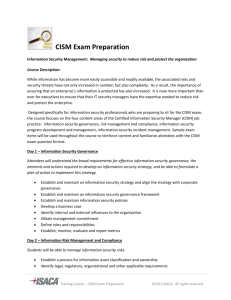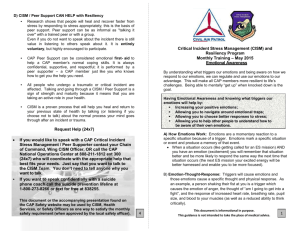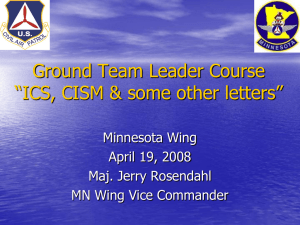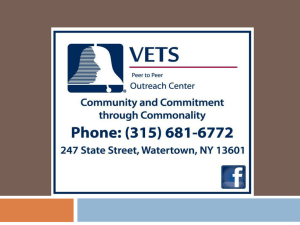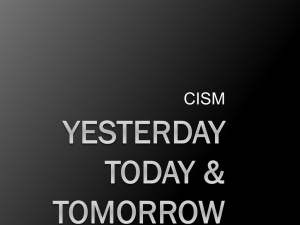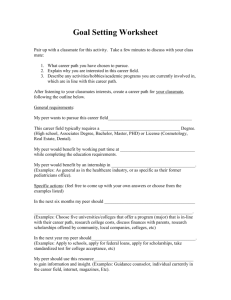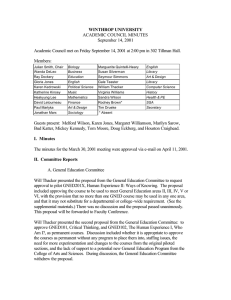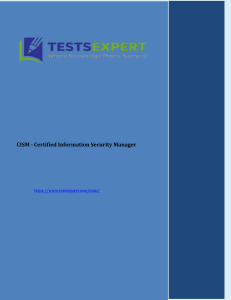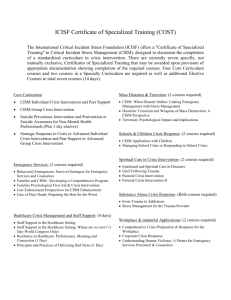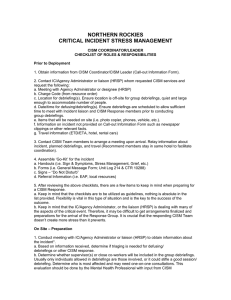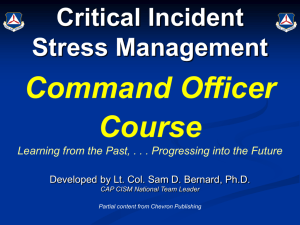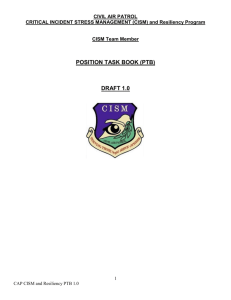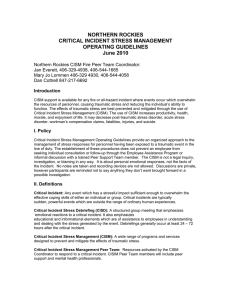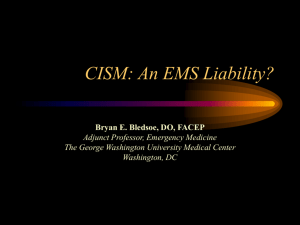5x8 Cards Template
advertisement
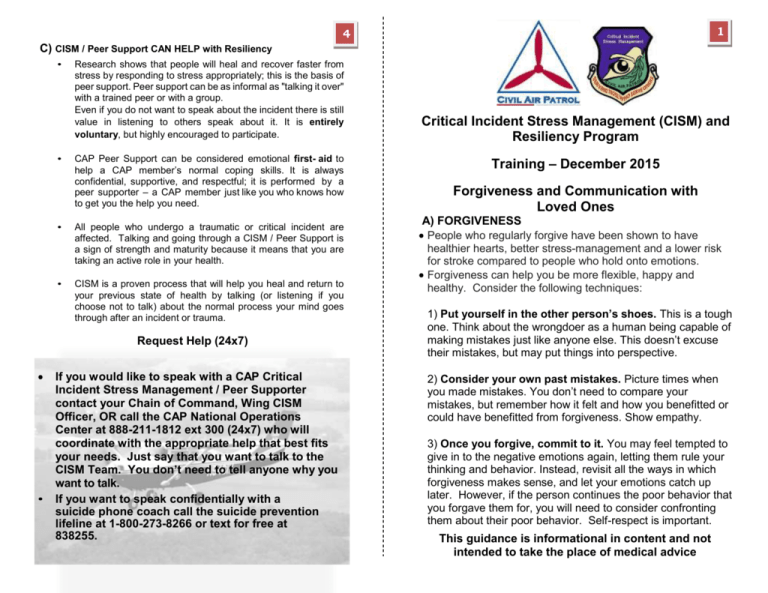
1 4 C) CISM / Peer Support CAN HELP with Resiliency • • Research shows that people will heal and recover faster from stress by responding to stress appropriately; this is the basis of peer support. Peer support can be as informal as "talking it over" with a trained peer or with a group. Even if you do not want to speak about the incident there is still value in listening to others speak about it. It is entirely voluntary, but highly encouraged to participate. CAP Peer Support can be considered emotional first- aid to help a CAP member’s normal coping skills. It is always confidential, supportive, and respectful; it is performed by a peer supporter – a CAP member just like you who knows how to get you the help you need. • All people who undergo a traumatic or critical incident are affected. Talking and going through a CISM / Peer Support is a sign of strength and maturity because it means that you are taking an active role in your health. • CISM is a proven process that will help you heal and return to your previous state of health by talking (or listening if you choose not to talk) about the normal process your mind goes through after an incident or trauma. Request Help (24x7) • If you would like to speak with a CAP Critical Incident Stress Management / Peer Supporter contact your Chain of Command, Wing CISM Officer, OR call the CAP National Operations Center at 888-211-1812 ext 300 (24x7) who will coordinate with the appropriate help that best fits your needs. Just say that you want to talk to the CISM Team. You don’t need to tell anyone why you want to talk. If you want to speak confidentially with a suicide phone coach call the suicide prevention lifeline at 1-800-273-8266 or text for free at 838255. Critical Incident Stress Management (CISM) and Resiliency Program Training – December 2015 Forgiveness and Communication with Loved Ones A) FORGIVENESS People who regularly forgive have been shown to have healthier hearts, better stress-management and a lower risk for stroke compared to people who hold onto emotions. Forgiveness can help you be more flexible, happy and healthy. Consider the following techniques: 1) Put yourself in the other person’s shoes. This is a tough one. Think about the wrongdoer as a human being capable of making mistakes just like anyone else. This doesn’t excuse their mistakes, but may put things into perspective. 2) Consider your own past mistakes. Picture times when you made mistakes. You don’t need to compare your mistakes, but remember how it felt and how you benefitted or could have benefitted from forgiveness. Show empathy. 3) Once you forgive, commit to it. You may feel tempted to give in to the negative emotions again, letting them rule your thinking and behavior. Instead, revisit all the ways in which forgiveness makes sense, and let your emotions catch up later. However, if the person continues the poor behavior that you forgave them for, you will need to consider confronting them about their poor behavior. Self-respect is important. This guidance is informational in content and not intended to take the place of medical advice B) COMMUNICATING WITH LOVED ONES Use these strategies to improve communications: 2 1 Strategy #1: Start gently Stable relationships display more positive emotions and fewer negative emotions during the first few minutes of a discussion. Therefore, when starting a discussion with your loved one, work on being “gentle” and starting “softly.” Strategy #2: Express and explain When there is something that you want to discuss with a loved one, the following guidelines may help you express your feelings more clearly and effectively. The “Speaker” should follow these guidelines: o Use “I” statements when describing your thoughts and feelings. “I” statements help the Listener not feel like they are being attacked and helps them hear you. o Be specific—only discuss one main idea at a time. o Pick a good time and place for talking with them. Strategy #3: Listen and hear The other half of communication involves listening to what the Speaker has to say so that you truly understand their feelings. The “Listener” can then follow these guidelines: o Summarize and restate what you heard. o Don’t question or react to what your partner said, offer solutions, or interpret the meaning. o Assess your tone of voice, facial expressions, and your posture to show you are open and not defensive. o Put yourself in the expresser’s shoes. Be empathetic. Strategy # 4: Take Turns Once one specific issue has been expressed and listened to, then partners switch roles. Strategies #2 and #3 can help you break communication down to the basics so each person can be heard. 3 Strategy #5: How to disagree 1 Conflict itself won’t destroy a relationship if the conflict is resolved well. However, the following four characteristics of arguments are “lethal” to relationships. Don’t use these Criticism involves attacking someone’s personality or character, rather than a specific behavior, and is usually accompanied by blame. Contempt includes words or thoughts that show a lack of respect for the person during an argument. Stonewalling, or Withdrawal, involves removing yourself in a way that suggests disapproval, distance, and smugness. Defensiveness happens when you verbally attack your partner and respond with excuses, denial of responsibility, negative solutions, and negative mind reading. Strategy #6: Repair When an argument happens, attempt a “repair” that defuses the conflict or stress of the discussion. One or both of you can defuse things by agreeing to disagree, bringing humor into the conversation, making gentle statements, and other ways. Focus on the positive and loving interactions with your loved one after a fight can help undo the negative effects. What works to repair one fight may not work on another. Strategy #7: Listen—don’t react We often respond directly to what our loved one is saying with our own reactions which may create a defensiveness that gets in the way of hearing what the other person is saying. Experts suggest that really listening to your partner (use strategy #2) rather than reacting emotionally will satisfy your partner’s needs rather than debate them. The hope is that your needs can be met in return. Strategy #8: Rebound/Resiliency from arguments It is important to rebound from an argument and interact with your partner in a positive way afterwards. Clearing the air each time after a conflict, learning from the disagreement, and sticking to the mutual agreements afterward have been shown to strengthen relationships Public Domain
